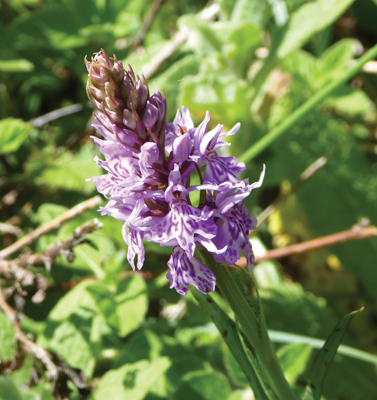The minor road that climbs past the Spyway Inn near Askerswell was quiet that day, a welcome relief from the seemingly endless traffic clogging the A35. Eventually, though, Eggardon Hill came into view, the road levelled out and our attention was captured by the stunning panorama laid out to the west. Below, the land unfolded in a mosaic of fields, trees and hedges with different colours and textures, backed by the hills of west Dorset rising mysteriously in the slight haze that softened the air. To the south west, the sea and the familiar ups and downs of the Jurassic Coast completed the image. We drove on and, just before the road dipped under the old railway bridge, turned into the car park at the Powerstock Common Nature Reserve.
Trees surrounded the car park and bright early June sunshine filtered through the leaf cover casting dappled light across the parking area. Birdsong echoed around us and the rippling sound of running water emerged from the nearby woodland. Common vetch scrambled through the fences along the car park edge and its purplish-pink pea-type flowers were proving popular with plump, furry, pale brown bumblebees.
We set out along the woodland path taking a right fork to stay on the northern edge of the reserve. The track felt enclosed but wildflowers grew along the margins including the inconspicuous bright blue speedwell and the purplish-blue spikes of bugle. In time, the woodland melted away leaving the path to run between broad sloping banks topped by trees and scrub. This is the Witherstone cutting, once the path of the Bridport branch railway as it ran between Powerstock and Toller stations.
This branch line opened in 1857 linking Bridport to Maiden Newton and the main line. The coming of the railway to West Dorset revolutionised social and commercial life in the area which, at the time, was poorly served by roads. People could travel more widely and I tried to imagine trains passing through the cutting, drawn in a haze of smoke and noise by the small steam engines of the Great Western Railway. I pictured people on the trains, travelling for work or for leisure or moving about during the two world wars. The line was also important for the transport of milk, watercress and the net and twine produced in Bridport. As motor transport came to dominate, traffic on the railway declined resulting in its closure in 1975. Although the tracks were lifted, there are still signs of the old railway, notably the rusty fence posts that line the track. The remains of an old brickworks can also be found in the nearby wood. This was set up near the railway to take advantage of the clay that remained when the cutting was excavated.
On the day of our visit, the sloping banks on either side of the path were mostly clad in short rough grass although there were some areas of exposed grey soil, perhaps a result of slippage. The former railway








